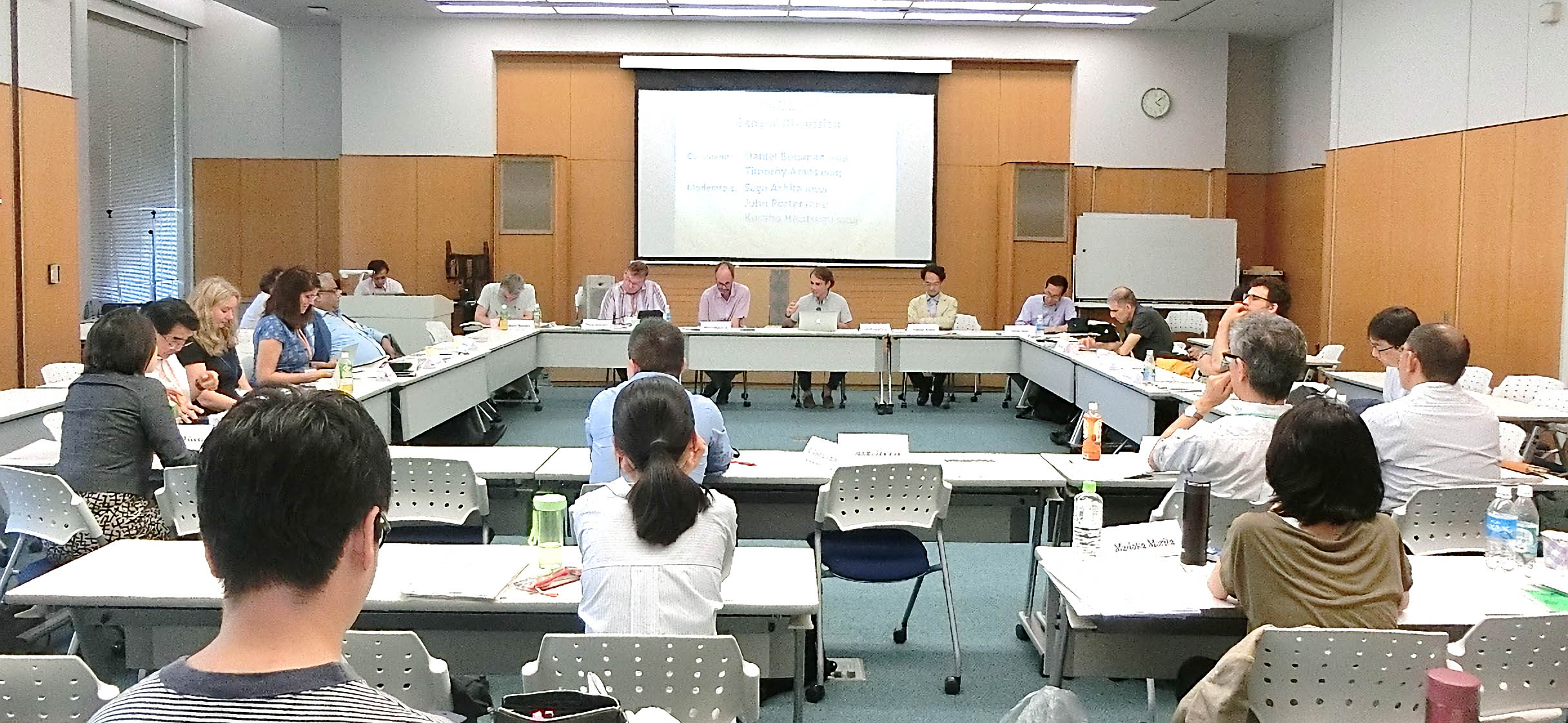This event was the General Symposium for the Marginal Social Groups’ Experiences of Modernity Project, an international collaborative research program involving Osaka City University (OCU), Yale University, the National University of Singapore (NUS), and Shanghai University. It took place over the weekend of 25-26 May 2019 in the Cultural Exchange Room on the first floor of the Osaka City University Media Center.
The symposium brought together the program’s collaborating overseas researchers from the United States, Singapore, China, and several other countries for scholarly exchange on the comparative history of marginal social groups during the transition from early modernity to modernity in Japan and other Asian regions. As a starting point for these conversations, emphasis was placed on the structure of each region’s social groups and the characteristics of the historical sources scholars have used to apprehend them. This approach made for a productive and far-ranging two days of debate and discussion: after an initial session that took early modern Japanese beggar (hinin) groups and associated sources as a framework for a broad comparative exchange, there were separate sessions devoted to the collaborating overseas scholars’ work on the social history of India, the Ottoman Empire, and other Asian regions. A final general session for further debate and reflection concluded the symposium.
Texts of each presentation were provided in both English and Japanese. Discussion was held bilingually as well, through sequential translation by participating junior researchers with knowledge of the relevant field (as opposed to externally contracted simultaneous translation by generalists) so as to facilitate communication without compromising on the use of specialized terminology.
Day 1: 25 May (Sat) 9:30am-5:00pm
Welcome Session
The symposium began with welcome addresses by Sakuragi Hiroyuki, Vice President of Osaka City University; Kobayashi Naoyuki, Dean of the Graduate School of Literature and Human Sciences; and Tsukada Takashi, Professor in the Graduate School and Program Leader for the Marginal Social Groups Project.
Sakuragi Hiroyuki
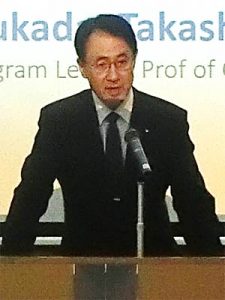 Vice President Sakuragi delivered his remarks in English. He began with OCU’s organization and history, describing the university’s origins in the Osaka Commercial Training Center (Ōsaka shōgyō kōshūjo) and the activities of founder Godai Tomoatsu, as well as its subsequent reorganization as the Osaka University of Commerce (Ōsaka shōgyō daigaku) through the efforts of Seki Hajime, the mayor of Osaka. He highlighted the maxim that Seki articulated when the new university opened in 1928: “it must not become a mere copy of the national universities.” Vice President Sakuragi then turned to OCU’s ongoing efforts at internationalization, affirming the aim of the Marginal Social Groups’ Experiences of Modernity Project in organizing the symposium shared also by the Urban-Culture Research Center (UCRC) at OCU and the School of Literature and Human Sciences as a whole namely, to strengthen and formalize the collaboration with overseas research institutions that has begun with Yale, Singapore, and Shanghai. He concluded by offering his best wishes for a successful symposium and thanks to the overseas guests.
Vice President Sakuragi delivered his remarks in English. He began with OCU’s organization and history, describing the university’s origins in the Osaka Commercial Training Center (Ōsaka shōgyō kōshūjo) and the activities of founder Godai Tomoatsu, as well as its subsequent reorganization as the Osaka University of Commerce (Ōsaka shōgyō daigaku) through the efforts of Seki Hajime, the mayor of Osaka. He highlighted the maxim that Seki articulated when the new university opened in 1928: “it must not become a mere copy of the national universities.” Vice President Sakuragi then turned to OCU’s ongoing efforts at internationalization, affirming the aim of the Marginal Social Groups’ Experiences of Modernity Project in organizing the symposium shared also by the Urban-Culture Research Center (UCRC) at OCU and the School of Literature and Human Sciences as a whole namely, to strengthen and formalize the collaboration with overseas research institutions that has begun with Yale, Singapore, and Shanghai. He concluded by offering his best wishes for a successful symposium and thanks to the overseas guests.
Kobayashi Naoki
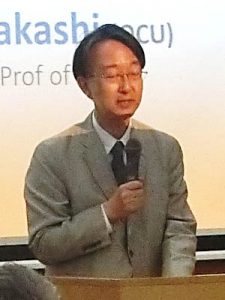 Dean Kobayashi, a professor of Japanese literature, addressed the symposium in Japanese. He reflected on the Graduate School’s international collaborative research efforts since OCU’s selection, in 2003, to the “21st Century Centers of Excellence” program of the Japan Society for the Promotion of Science, which coincided with the establishment of the Urban-Culture Research Center. The Marginal Social Groups project, he noted, represents a continuation of those efforts.
Dean Kobayashi, a professor of Japanese literature, addressed the symposium in Japanese. He reflected on the Graduate School’s international collaborative research efforts since OCU’s selection, in 2003, to the “21st Century Centers of Excellence” program of the Japan Society for the Promotion of Science, which coincided with the establishment of the Urban-Culture Research Center. The Marginal Social Groups project, he noted, represents a continuation of those efforts.
He then offered an example from his own field of research, Japanese literature, that has deeply informed his understanding of the importance of archives, one of the titular themes of the symposium. Classical Chinese literature exerted a profound influence on Japanese literature, but there are many examples of Chinese works that were lost in China and preserved only in Japan, a situation which has itself shaped the development of research styles and methodologies in the two countries.
With these points in mind, Dean Kobayashi emphasized the valuable opportunity that the symposium represented to use the nature of historical documents to think through the defining characteristics of early modern Japanese society, which generated and transmitted down to the present such a rich archive of primary sources.
Tsukada Takashi
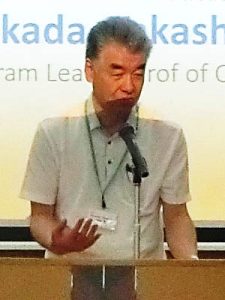 Lastly, Prof. Takashi gave opening remarks as leader of the project, providing an overview of its origins and accomplishments. Marginal Social Groups was selected for funding by the JSPS in 2017 and its formal activities began in the second half of that year. Subsequently, the project sent six junior researchers to Yale, Singapore, and Shanghai for extended periods of stay and hosted seventeen special research workshops at OCU. In addition, the collaborating overseas research institutions hosted seminars and primary source workshops of their own. The General Symposium was intended to serve as a capstone for these collective efforts. By bringing together collaborating overseas researchers not only scholars of Japanese history, but of Asia at large for debate and discussion, the project also aimed to bring OCU’s efforts at internationalization to a new level. Prof. Tsukada concluded his remarks by welcoming the overseas researchers and offering particular thanks to Professor Kotani Hiroyuki, a special guest to the symposium.
Lastly, Prof. Takashi gave opening remarks as leader of the project, providing an overview of its origins and accomplishments. Marginal Social Groups was selected for funding by the JSPS in 2017 and its formal activities began in the second half of that year. Subsequently, the project sent six junior researchers to Yale, Singapore, and Shanghai for extended periods of stay and hosted seventeen special research workshops at OCU. In addition, the collaborating overseas research institutions hosted seminars and primary source workshops of their own. The General Symposium was intended to serve as a capstone for these collective efforts. By bringing together collaborating overseas researchers not only scholars of Japanese history, but of Asia at large for debate and discussion, the project also aimed to bring OCU’s efforts at internationalization to a new level. Prof. Tsukada concluded his remarks by welcoming the overseas researchers and offering particular thanks to Professor Kotani Hiroyuki, a special guest to the symposium.
Session I: Social Groups and Historical Documents in Japan
In this session, Prof. Tsukada gave a presentation entitled “Beggar Status Groups and Historical Sources in Early Modern Japan: An Examination of Osaka’s Kaito nakama”. A paper of his on these themes had been translated and distributed in advance, with a view to providing a center of gravity for the symposium, and it prompted a rich exchange of ideas in the discussion. The main points of Prof. Tsukada’s presentation are summarized below.
The early modern society of Japan gave rise to, and left behind, a quantity of documentary sources (komonjo) perhaps unequaled in world history. In particular, scholars in the West are often taken aback that even associations of beggars (hinin) composed and passed down such documents. As described in the pre-distributed paper, it was early modern villages and, in urban areas, neighborhood block communities (chō) that created these documents. This phenomenon arose, in key respects, from the peculiar structure of early modern Japanese society, in which governing authority was distributed among various status groups. As an illustrative example of early modern hinin groups, Tsukada gave an overview of the Kaito nakama groups in Osaka. The hinin of Osaka, concentrated in four areas known as kaito (lit. “beyond the pale”), were originally groups comprised of beggars and poor people who had trickled into the city. Their begging activities were officially sanctioned by the authorities, but this came with the imposition of duties primarily policing new beggars who entered the city and performing various other official tasks/errands for the magistrate and so afforded these marginal groups a formalized place in urban society. They developed into hierarchically stratified organizations with their own internal laws for the status group.
In his research into Osaka’s hinin, Tsukada worked with the Hiden’in monjo, internal documents produced by the Kaito associated with Hiden temple, and, for the Dotonbori area, a source (Hinin kaito ikken) produced by Nanba village, which controlled the land occupied by the Kaito there. Tsukada noted, in light of the symposium’s central themes, the contrasting nature of the sources: the former documents produced by the beggar group internally; the latter produced externally by the headman of the (non-beggar status) village. The first source sheds light on the internal organization of the group as well as its relationships, from the group’s own perspective, with the city magistrate and other external status groups. Likewise, the second is useful for understanding the village, the beggar group, and the relationship between them from the perspective of the village. Together, Prof. Tsukada noted in conclusion, they allow both multi-layer analysis of the beggar group’s internal structure and composite analysis of how it was connected to the society beyond it. (The presentation was translated for the audience by Prof. John Porter).
Lively discussion and debate followed Tsukada’s provocation. Professors Inoue Tōru (Chinese history), Gyanesh Kudaisya (Indian history), Alan Mikhail (Ottoman history), Annu Jalais (anthropology of India), and Rohit De (Indian history) had been asked to prepare comments and each presented in turn. Many of their questions and comments had to do with comparisons that might be drawn between the hinin of early modern Japan and status/caste groups of the Indian subcontinent. They can be organized into the following five categories: 1) the functions of beggar groups and villages and the division of labour with other groups; 2) beggars’ ability to produce documents (the question of literacy) and the production and transmission of documents in villages; 3) the social and historical nature of groups’ begging activities, especially whether they had religious significance; the question of by whom, from whom, and according to what logics solicitations were made; 4) connections between modernization (westernization)/colonization and begging groups; 5) the social reproduction of hinin groups.
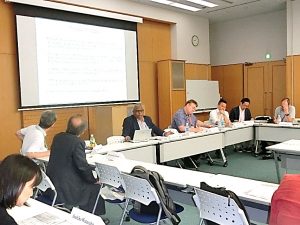 Tsukada addressed these topics as follows: 1) lordship in early modern Japan was based on hereditary succession (and was unremarkable in that respect); what distinguished it, however, was the indirect mode of rule exercised over commoners (the mura-ukesei), in which lords went through villages (i.e., as subordinate but largely self-governing units) to acquire knowledge about and tax their subjects. Both economic activity and the social order were structured through the ruling authorities’ official recognition of the activities and practices of various individual social groups that specialized in some aspect of the division of labor. Thus endowed with status, these groups were responsible for their own maintenance and development.
Tsukada addressed these topics as follows: 1) lordship in early modern Japan was based on hereditary succession (and was unremarkable in that respect); what distinguished it, however, was the indirect mode of rule exercised over commoners (the mura-ukesei), in which lords went through villages (i.e., as subordinate but largely self-governing units) to acquire knowledge about and tax their subjects. Both economic activity and the social order were structured through the ruling authorities’ official recognition of the activities and practices of various individual social groups that specialized in some aspect of the division of labor. Thus endowed with status, these groups were responsible for their own maintenance and development.
2) In early modern Japan, documents were produced not just at the village level, but also within the households that comprised the larger community. As such, a considerable proportion of people were literate. Beggar groups also generated documents, and these were not authored solely by the community elite. 3) Religious begging of the kind common in India was also seen in medieval Japan, but in the early modern period it became secularized and systematized. There were, however, many mendicant religious practitioners outside the hinin status category as well. 4) As for the fate of status groups during modernization, there was a prominent distinction between hinin and eta (the ritually impure, e.g. leather workers). The former dissolved rapidly since it was a status group specialized in official services (to the samurai rulers, e.g., executions) and begging; the latter, however, survived within the context of local economic and social relationships. 5) In terms of social reproduction, the hinin of Osaka, as noted in the presentation, settled on the margins of the city and formed into coherent groups in the seventeenth century. In the eighteenth century the elite within hinin communities solidified as a self-reproducing class, while the ranks of middle and lower classes were replenished through the influx of impoverished people from outside the city. Prof. Daniel Botsman translated these responses for English speakers in the audience, also providing supplementary explanations of Prof. Tsukada’s work and basic concepts and terminology in early modern Japanese history.
Special guest Professor Kotani (Indian history) then weighed in on the discussion relating to points 1) and 4). He noted that when comparing groups subject to discrimination in Japan and India it is indeed possible to draw equivalences between Dalit and eta statuses; however, one must bear in mind that there was no group/caste in India equivalent to Japan’s hinin. Additionally, Prof. Kotani’s raised an issue of fundamental importance when comparing different societies, namely, how to translate terms. He cautioned that while the questions about mendicancy discussed in point 3) would involve, in the Indian context, the practice of almsgiving known as dāna, in India it is typically high-status persons such as Brahmins that are the objects of almsgiving. Using the English “alms” indiscriminately to refer to both the Indian and Japanese situations could lead to confusion.
There was not time enough to address the many themes that cropped up over the course of this far-ranging discussion, but overall it provided an exchange on the nature of status groups and historical sources in early modern Japan that was considerably in-depth as well as stimulating for participants, whether as scholars of Japan or other Asian societies, or as native speakers of English or Japanese.
Session II: Economic Transformation and Social Groups in India
In the second session, Gyanesh Kudaisya (National University of Singapore) gave a presentation on “Ideas of Self-Help and Cooperative Grassroots Experiences: Partition Refugees in Contemporary India.”
The partition of India in 1947 gave rise to a large number of refugees. Because governmental institutions provided only short-term relief, long-term rebuilding of lives proceeded through the grassroots efforts of ordinary people. The presentation examined the rise of self-help and cooperative thought within the context of these social struggles. The Indian Cooperative Union, led by Kamaladevi Chattopadhyay, worked closely with female refugees and promoted their self-reliance, which provided the impetus for the rebirth of regional handicraft industries. Meanwhile S. K. Dey established a job training facility in a refugee camp in East Punjab, which developed into a cooperative township of more than seven thousand people. This was an early and revolutionary example of coordination between civil society and the state and will become an important object of research for understanding the history of self-help and cooperation.
Questions for Prof. Kudaisya were as follows: Prof. Daniel Botsman used the example of Kagawa Toyohiko, who engaged in similar projects to those of the two activists discussed in the presentation, to frame his question: despite his reputation and fame outside Japan as “the Japanese Gandhi”, we cannot simply describe Kagawa as “a doer of good deeds”. When it comes to such figures, is there not a need to bring the political background into the picture in formulating our evaluations of them? Prof. Kudaisya responded by noting that while the two activists he discussed did have political goals, they took an oppositional posture to state authority. Next, Prof. John Porter remarked that the presentation brought to mind the situation of hinin in Japan, who lost their means of subsistence and standing in the Meiji, and so had to find new ways of making a living. He suggested that the problems discussed in the presentation might profitably be linked to problems of a similar character that emerged in the Tokugawa-Meiji transition.
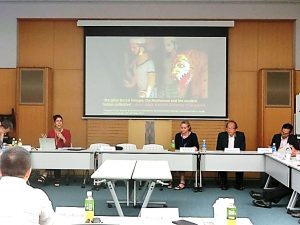 Prof. Rohit De pointed out that we cannot treat the migrants as a homogenous group given that their experiences varied widely depending on differences in points of origin, where they ended up, and class position. The cases raised in the presentation were not necessarily examples of success, and did not achieve their goals in certain respects. Prof. Kudaisya asserted that what was most important here is that the concepts of self-help and cooperation took root in society and came to be held widely among the populace and, in that respect, the efforts can be called successful.
Prof. Rohit De pointed out that we cannot treat the migrants as a homogenous group given that their experiences varied widely depending on differences in points of origin, where they ended up, and class position. The cases raised in the presentation were not necessarily examples of success, and did not achieve their goals in certain respects. Prof. Kudaisya asserted that what was most important here is that the concepts of self-help and cooperation took root in society and came to be held widely among the populace and, in that respect, the efforts can be called successful.
In closing, Prof. Kudaisya spoke about his plans for furthering his research, through examples of small enterprises, into how partition refugees rebuilt their lives. Session II’s presentation and discussion affirmed a common understanding among participants of how refugees can be analyzed as a marginal social group. On groups’ autonomous development and their connection with the state, in particular, this session provided an opportunity for drawing comparisons and links to different regions and groups.
Session III: Marginal Social Groups in India
The third session was devoted to Prof. Annu Jalais’s presentation: “Marginal Groups, the Non-human, and the Modern Indian Collective.”
In India, there have been many lynchings over the treatment of cows. The vast majority of victims have been from groups subject to discrimination, namely Muslims and Dalits. Disputes about cows have had to do not only with (the violation of) sacredness and purity, but with the pollution that attaches to the bodies of Muslims and Dalits through their consumption of cows. Hindutva, waving the banner of Hindu nationalism, judges people for what they eat and views (non-Hindu) minorities as non-citizens. By contrast, the people of the Sundarbans, the mangrove island forests of Ganges River Delta, have strong connections with the land and non-human animals such as tigers, but do not emphasize caste distinctions as much as city-dwellers do. Environmental protection as conceived of by Hindutva-supporting urban middle classes does not consider the rights of the people of the Sundarbans and seeks to eliminate their customs. By comparing understandings of cows among the bourgeoisie and of tigers in the Sundarbans, Jalais argues that we can observe different concepts of the non-human and collectivity at work.
Questions and comments for Prof. Jalais were as follows: Prof. Kotani provided some background on the meaning of (female) cows for Hindus and that of tigers for forest fishers. Among Muslims there are festivals involving the sacrifice of cattle, which Hindu’s have decried, leading to movements for the institution of laws protecting female cows. The implementation of the census in India also caused people to become conscious of their religions as categories in ways they previously had not been, which led to a proliferation of new subdivisions among castes.
Next, Prof. Tsukada noted that it was interesting that in Japan environmental movements are associated with the political left, but in India with the right. It brought to mind the attacks by extremist environmental groups on Japan’s whaling activities. He also remarked on the need to approach these problems through the structures people build in social relationships, for in limiting analysis to the conceptual level it produces a fixed idea of “people in the forest do not distinguish between human and non-human.”
Dr. Morita Madoka offered a comparison from the context of the Ottoman Empire, which was tolerant towards non-Muslims. In early modern Istanbul, Jews, who made up approximately five percent of the city’s population, had a special right to fifteen percent of the meat that entered the city. Additionally, while Muslims were subject to exile for consuming alcohol, Christians were permitted wine. It is uncertain whether the butchering of animals for meat was viewed with contempt or became a basis for discrimination as in Japan and India. Prof. Mikhail added that when thinking about the non-human we need to think about the concepts we use. He offered that he tries to understand human society through things that are not human, while noting that there are different ways of approaching the non-human.
In this session, a shared understanding developed among participants that marginality and the modernization process in the Sundarbans become visible through an analysis of connections among humans, nature, and animals. This provided a basis for expanding comparisons and inquiries involving these connections in other regions.
Day 2 May 26 (Sun) 9:00am-5:00pm
Session IV: Law and Society in Modern India
The fourth session featured Prof. Rohit De of Yale University, who introduced his new book on society and the Indian Constitution after independence.
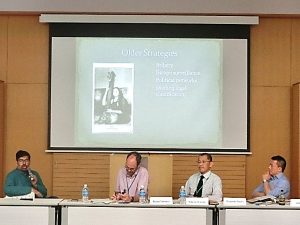 Until recently, the post-independence Indian Constitution has been viewed as something of no interest to the masses, but in fact this is not so. To demonstrate this unappreciated reality, De uses the archives of India’s Supreme Court, focusing on records of cases involving petitions. Prostitution had been made illegal in the new constitution, but a woman known as Husna Bai filed a petition challenging the prohibition, arguing that she would not be able to support her family if she could not practice prostitution. The case received much attention in the media. We can see that there was a kind of network among prostitutes, for multiple other women filed suits almost simultaneously with Husna Bai’s. Ultimately, these petitions were dismissed (on technical grounds), but in its opinion the Supreme Court did find that prostitution was a profession freedom of which was guaranteed in the Constitution and that banishment of prostitutes (from jurisdictions where they plied their trade) constituted a violation of their fundamental rights. There are many who say that even if people on the margins of society can and do initiate legal action, it is elites that sit in judgment, and since this will ultimately stymie the former’s efforts, what is called for is not attempts to leverage the law, but social movements. However, this is not necessarily the case. Victory and defeat in the courtroom are not what is important. Through petitions, people actively tried to use the Constitution, understanding that this offered the possibility of achieving recognition of the rights guaranteed therein. As such, the Constitution had meaning to ordinary people as well.
Until recently, the post-independence Indian Constitution has been viewed as something of no interest to the masses, but in fact this is not so. To demonstrate this unappreciated reality, De uses the archives of India’s Supreme Court, focusing on records of cases involving petitions. Prostitution had been made illegal in the new constitution, but a woman known as Husna Bai filed a petition challenging the prohibition, arguing that she would not be able to support her family if she could not practice prostitution. The case received much attention in the media. We can see that there was a kind of network among prostitutes, for multiple other women filed suits almost simultaneously with Husna Bai’s. Ultimately, these petitions were dismissed (on technical grounds), but in its opinion the Supreme Court did find that prostitution was a profession freedom of which was guaranteed in the Constitution and that banishment of prostitutes (from jurisdictions where they plied their trade) constituted a violation of their fundamental rights. There are many who say that even if people on the margins of society can and do initiate legal action, it is elites that sit in judgment, and since this will ultimately stymie the former’s efforts, what is called for is not attempts to leverage the law, but social movements. However, this is not necessarily the case. Victory and defeat in the courtroom are not what is important. Through petitions, people actively tried to use the Constitution, understanding that this offered the possibility of achieving recognition of the rights guaranteed therein. As such, the Constitution had meaning to ordinary people as well.
Prof. Yasutake Takahiko began the Q&A with a question using Japan as a basis for comparison. He noted that while Japan does have a system of judicial review, the Supreme Court is extremely reluctant to apply it and has hardly recognized any charges of unconstitutionality brought before it. The Indian Supreme Court is apparently very proactive in intervening against legislative and executive power. How is it able to do this? In his answer, Prof. De referenced a sarcastic analogy of judges as mice that eat holes in the great pillar that is the Constitution: the Supreme Court of India is by no means an ally of the masses, but it does engage quite actively against the government.
Next, Dr. Morita asked what changes took place in the Supreme Court between the colonial period and independence, and also what effect the failed petitions had in society. With regard to the former, Prof. De explained that the biggest change was that people came to bring suits against the state itself rather than only their neighbours or relatives. As for the latter, he reemphasized his position that what is important is not whether the petitions succeeded or failed, but the process by which the Constitution became the means of intermediation between state and society.
Prof. Tsukada, referencing the problems of language brought up in previous sessions, asked why India’s Constitution was written in English. Prof. De explained that many languages were spoken in India, even within the region in question, and gave an overview of how English came to be decreed the language of state in 1857. For India, English is not merely a language that came in from outside, and it was through English that it became possible to narrate a shared (national) history of India.
This session helped deepen discussion of movements among individuals and in society with respect to law through comparisons between India and Japan and a robust exchange of views from diverse perspectives.
Session V: Animals and Modernization in the Ottoman Empire
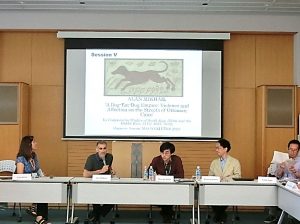 In the fifth session, Prof. Alan Mikhail (Yale University) presented an overview of his research into the changes that took place in human-animal relationships in Ottoman Egypt during the shift from early modern governance to the centralizing state of the nineteenth century. Through this type of analysis, he offered a framework for understanding the course of the transition between early modernity and modernity..
In the fifth session, Prof. Alan Mikhail (Yale University) presented an overview of his research into the changes that took place in human-animal relationships in Ottoman Egypt during the shift from early modern governance to the centralizing state of the nineteenth century. Through this type of analysis, he offered a framework for understanding the course of the transition between early modernity and modernity..
Human-animal relationships, which had constituted the foundation of economic activity and social life across the world, started to change between 1750 and 1850. Prior to this era, animals made up an enormous proportion of available labour power, especially for the poor in rural society and cities. Early modern Egypt, a society distinguished by the vibrancy of its human-animal relations, began to transition into a society where those relations were no longer the basis of life and commerce. In the early modern period animals had been the subject of commercial dealings as presents to the sultan, with elephants, tigers, and lions brought from Iran, North Africa, and other distant lands. In the nineteenth century, however, they came to be collected into zoos for the amusement of the ordinary masses. The dogs of Egypt’s cities, which had lived in a sort of symbiosis with humans by eating their waste, saw that connection severed: marked as non-human, they were purged from cities, becoming, as did the humans left behind, the objects of strengthening state control.
The Q&A proceeded as follows: by way of comparison with the fate of stray dogs in Egyptian cities becoming mismatched with the new human society and thereby, in the nineteenth century, an object of elimination Prof. Jalais brought up the example of relationships between dogs and humans in Bangladeshi villages, where dogs are respected for their capacity for loyalty towards humans and it is thought that humans are reborn as dogs. This attitude towards dogs differs from the usual one in the Islamic world, and reflects the influence of Hinduism.
Next, Dr. Shimazaki Mio offered a comparison with human-animal relationships in Japan. She explained that in the early modern period, while dogs were kept as symbols of warrior authority or as guard dogs in both cities and villages, strays were numerous and there were examples of abuse. Governmental regulation of the abuse of dogs (as in the shogun Tsunayoshi’s Laws of Compassion) did not stem solely from affection, but also efforts to maintain social control by clamping down on the anti-social act of killing to consume flesh. Given this, Dr. Shimazaki asked if it would be appropriate to understand dog-human relationships in (early modern) Cairo as exclusively economic. Further, with regard to abuse of dogs and examples of punishment thereof, she asked whether this issue should not be approached through the motives of those who abused dogs and the logic behind the authorities’ punishments.
Prof. Saga Ashita brought up horses in modern Japan, which continued in their long-standing role in agriculture, but for a period of forty years were simultaneously subject to breeding programs for westernization and hybridization in order to increase their size for potential military use. He asked about horses in Egypt and, more generally, whether there might not be ways of conceptualizing the relationship between modernization and animals other than the binary of “affection and elimination.”
In response to these questions and comments, Prof. Mikhail emphasized that the closeness of the connection between dogs and humans is a central question. As for how premodern human-dog relationships could range between contempt and love, he offered the examples of the dog used to check the ruler’s food for poison and the old woman who held a funeral for her dog as if it had been her child. With regard to horses, in the Ottoman Empire they were high-value animals mostly used for military purposes. As for animal labour in the fields, the basic Ottoman unit of land was the area that could be plowed by two oxen.
Overall, this session made for deep discussion of changing human-animal relationships, with a variety of opinions advanced from different regional perspectives.
Session VI: Historical Sources and Marginal Social Groups in India
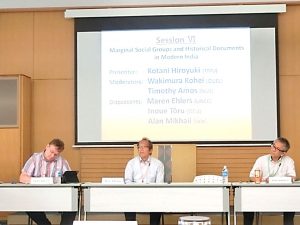 The sixth session was devoted to Prof. Kotani Hiroyuki’s research. His presentation was entitled “The Marginalized in Caste Society: Loss of Caste in Eighteenth-Century Maharashtra.”
The sixth session was devoted to Prof. Kotani Hiroyuki’s research. His presentation was entitled “The Marginalized in Caste Society: Loss of Caste in Eighteenth-Century Maharashtra.”
In most cases, loss of caste membership was due not to a person’s falling into destitution or disease, but expulsion for the violation of caste rules related to eating and drinking. There were both temporary and permanent expulsions. Two examples of women who were expelled from their castes are recorded in both official and private Marathi-language documents produced in the Maharashtra region, which was under the control of the Maratha Empire in the eighteenth century. The first involved household slaves known as kunbin or batkin, and the second an association of kalavantin dancing girls. The former left their families and caste and eked out a living being passed around among other households; the latter comprised a type of performers’ collective that also functioned as a refuge for women who had lost caste membership. Men who lost caste membership, by contrast, assuming they were actually able to stay alive, might fall into servitude as dasa (male slaves) or end up joining mountain clans or the untouchables, but this is hard to confirm in the sources. It may have been significantly more difficult for men who lost cast membership to maintain some kind of livelihood than it was for women.
The Q&A proceeded as follows: Prof. Maren Ehlers offered some remarks on the use of the term “outcaste” and then, drawing a comparison to early modern Japanese history, observed that the Tokugawa status system was in some respects more flexible than India’s.
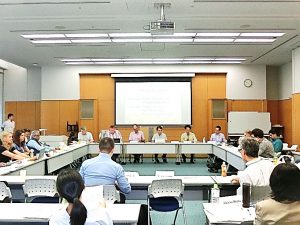 Prof. Inoue Tōru, by way of comparison with Chinese history, asked the following questions: 1) on the subject of liberation from caste, how did the nature of castes as religious groups relate to state authority? 2) Were state authorities involved in caste expulsions as a punishment? He also remarked on the differences between India and China in terms of their states and associations of individuals. With regard to the clan in China, he addressed its social and geographic fluidity. Clans had regulations whose violation supposedly could not be forgiven even in death, but we do not know whether these were actually backed by coercive force. It is unclear what happened to people who were ejected from the clan, but there seems to have been an attitude of nonchalance towards ostracism. Prof. Alan Mikhail also offered comments on outcastes, circumstances within the household, and the significance of female slaves’ having stronger a position than mothers.
Prof. Inoue Tōru, by way of comparison with Chinese history, asked the following questions: 1) on the subject of liberation from caste, how did the nature of castes as religious groups relate to state authority? 2) Were state authorities involved in caste expulsions as a punishment? He also remarked on the differences between India and China in terms of their states and associations of individuals. With regard to the clan in China, he addressed its social and geographic fluidity. Clans had regulations whose violation supposedly could not be forgiven even in death, but we do not know whether these were actually backed by coercive force. It is unclear what happened to people who were ejected from the clan, but there seems to have been an attitude of nonchalance towards ostracism. Prof. Alan Mikhail also offered comments on outcastes, circumstances within the household, and the significance of female slaves’ having stronger a position than mothers.
In its focus on the activities of women expelled from their castes, this session provided a platform for deep comparative discussion of outcastes in Japan and China, illustrating the forms of social fluidity present in each society and the people who constituted groups on the margins of the dominant social order.
Session VII: General Discussion
In this final session, participants worked through the discussion and debates that had been had over two days to think about the broader significance of the symposium’s themes.
Prof. Daniel Botsman began the discussion by thanking the organizers of the symposium for their ambitious and innovative efforts. He highlighted how their aim had been to provide a space for bridging across barriers of language and academic speciality and that participants had in fact been able to engage productively and enthusiastically despite being amateurs in each other’s fields. He then offered some comments on the connection between the “early modern,” Westernization, and especially the building of empire. In thinking about modernization in Asia, the impact of Westernization and imperialism are impossible to ignore. Japan was not somehow outside this dynamic. In early modern Japan, Western influence was circumscribed and eventually purged through the suppression of Christianity, but in fact the intensity of this response demonstrates precisely the strength of the field of normative power that Japan was exposed to, such that its policies might even be called “anti-early modern.” Typically the anti-Christian policies are interpreted as having arisen from concerns about proselytization and conquest, but we cannot ignore the rejection of human trafficking and slaughter of cows as part of their purpose.
He then turned to the necessity of comparisons between the caste system and Japan’s status system, arguing that more comparative work is needed, in all societies, on the social position and internal organization of status groups and their larger social orders. He called for such work on Asian societies to engage with (Prof. Tsukada’s) “theory of status margins” (mibunteki shūenron).
Lastly, Prof. Botsman reflected on his experiences as a researcher outside Japan who wanted to read early modern documents and how Prof. Tsukada, who maintains that “everyone is equal before the sources,” had shown him the ropes over the many high obstacles to that goal. He expressed his gratitude, explaining also that many of the English-language scholars of Japanese history participating in the symposium had likewise been the beneficiaries of his generous and patient instruction.
Next, Prof. Timothy Amos offered the following three observations summarizing the two days of discussion. First, with regard to the shared concepts of “social groups” and “marginalization”, he noted the extraordinary diversity of groups, even “animals” and the “non-human”, that were taken up during the symposium. They were defined variously by their relationships with official authority or regional politics and social orders, and there were also examples where exclusion by class and gender operated internally. Additionally, he pointed out that “marginalization” is also a function of trying to work from the level of available documents and of the perspectives we take as scholars trying to understand groups already defined as “marginal.” While keeping those limitations in mind, “marginalization” is a phenomenon that, for the individual and the group, involves some sort of loss or deprivation. When groups with a (political) consciousness of that deprivation are engaged in a process of attempting to redress it through movements against inequality, researchers must take care to study them through careful and considerate analysis of sources.
Second, on the significance of historical sources that shed light on marginal social groups, particularly legal documents, he observed that as a result of their use in many texts and reports, “law” has caused transformations in the “life” of marginalized people and groups, that is, it has served to catalyze efforts towards new forms of “life” that incorporate people’s movements and self-assertion. As such, attention to the law and legal sources can be particularly effective.
Third, in terms of the theoretical significance of the comparative historical ruminations that took place over the two days, the work of comparison moves from 1) observations of superficial and partial similarity to 2) a consciousness of the many differences that dissolve the apparent similarity, but thereby 3) that comparison, through synthesis of these overlapping logics, becomes a tool for deep exploration of social phenomena and illumination of the structures that underlie history and the experience thereof.
Prof. Amos concluded by observing that discussion of the early modern history of marginal groups and their experiences of modernization is all the more urgent today, when ruptures and marginalization of people are, if anything, intensifying.
Following these provocations, discussion was opened to comments from the floor. Prof. Jalais remarked that it is essential to keep modernization within the West in our field of view as an object of comparison, and that oppression and exclusion of marginal social groups represents an equally, if not more, fundamental problem under modernity as well. Prof. De emphasized that there must be further discussion of how to read legal sources while keeping in mind that they capture only a limited part of social reality and have specific limitations as texts. Prof. Nomura Chikayoshi brought up the problems of the structure of activist movements and of literacy rates as a condition for the production of documentary records in postcolonial India. Prof. Kudaisya weighed in by insisting that while there are indeed fewer sources for marginal social groups than in Japan, court records are not exactly scarce and since there are also sources left by these groups’ representatives and intermediaries, it is possible to approach them through these archival avenues. Prof. Jalais then offered a reminder of the importance of traditions of oral transmission in premodern India.
Shifting the discussion to Japan, Prof. Botsman asked Prof. Tsukada whether the documents of early modern Osaka’s beggar groups (kaito nakama) can really be understood as the subaltern speaking, given that the Kaito, as organizations, were part of the apparatus of rule. Are these records not precisely the sort of intermediary sources that the group had just been problematizing? Prof. Tsukada replied that that might be the case if only “wild” beggars (no–hinin; i.e., individuals not incorporated into the nakama) are considered to be “subaltern”, but the records produced by the kaito (the Hiden temple documents) contain not just the voices of the beggar chiefs (chōri), but also many from the sub-bosses (kogashira) and those even lower still in the hierarchy. And, turning things around, neither is it the case that the voices we hear in so-called “village documents” (murakata monjo) are exclusively those of commoners. What is important is how we use such sources to analyze group structures. Prof. Tsukada highlighted Prof. De’s problematic of “how to read legal sources” as crucial, noting that a similar concern had deeply informed the cross-analysis he gave in his presentation on the 25th of the Hiden temple and Namba village documents. When taking up the problem of law (in early modern Japan), it is not only possible but deeply necessary to read not just public (i.e., the ruler’s) law but also internal status and inter-group laws into the analysis alongside each subject’s position and the social relationships shown in the documents. In response to this explanation, Prof. De noted that in subaltern studies “subaltern” refers to people who do not author their own documents, so from that perspective the kaito nakama would not be considered “subaltern.” However, Prof. Kudaisya argued that it is valid to include as “subaltern” those groups that may have left documents but were also subordinate in terms of the social order. Prof. Botsman offered that there is a range of opinions within subaltern studies itself and that there are also some differences with the marginal status groups approach (as practiced by Prof. Tsukada and others).
To conclude the general discussion session, Prof. Saga Ashita noted that when comparing the transmission and preservation of sources, a distinction has to be made between situations where records were produced but do not survive and those where they were never produced at all. In Japan, social groups organized around localities, that is, villages and urban neighborhoods, were involved in the production of legal documents, of which a great number have survived; but from Prof. Kotani’s presentation we learned that such documents were also, at the very least, produced in India as well. He asked for further clarification on this point. Prof. De explained that at the beginning of their rule in India the British referenced and made use of preexisting local documents relating to land ownership and selectively preserved some of these, but most were lost or disposed of.
These remarks concluded the general discussion. Through debate over the methodological connections between the status margins approach and subaltern studies, this final session made for a deep and broad engagement with methodological issues that will remain at the center of comparative history going forward.
Bringing the symposium to an end, Prof. Tsukada thanked participants on behalf of the organizers for the two days of stimulating discussion and expressed their hope that both shared scholarly foundations and differences of field would provide a basis for advancing discussion and exchange.
On the following day, May 27, a walking tour of urban Osaka was held for the overseas guests, visiting the Doshōmachi, Dōtonbori, and Tobita Shinchi areas. On May 29, as an appendix to the symposium, another seminar was held at OCU featuring Prof. Maitrii Aung-Thwin (Burmese history). For a synopsis of his presentation, please refer to the proceedings of the workshops (No. 18).
